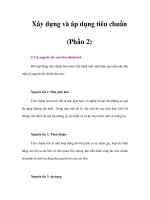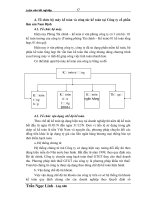Preparing Financial Statements phần 2 pps
Bạn đang xem bản rút gọn của tài liệu. Xem và tải ngay bản đầy đủ của tài liệu tại đây (277.91 KB, 10 trang )
3
Study Period 1 continued
Were you awake?
If you've been concentrating, you should be able to answer some key questions.
Who are the users of financial information?
What are the main financial statements?
What are the desirable qualities of good accounting information?
Expenditure on a desk is revenue expenditure. True or false?
Any problems?
Email (accaqueries @bpp.com) fax (020 8740 2293) or phone us (020 8740 2242/2245)
Learning Resource Centre
What do you want to do? How to do it! Reference
Test your knowledge BPP i-Pass *
Session 1: Intro and the
regulatory framework
Learn interactively BPP i-Learn/BPP Virtual Campus Module 1
Improve your study skills
BPP's Learning to Learn
Accountancy book *
* Included within your Home Study course
If you want any of these products, visit:
www.bpp.com/acca
Common Pitfalls
• Ignoring the needs of the different user groups
• Confusing capital and revenue expenditure
4
Study Period 2
The accounting equation
Priority = Medium
Date due:
Exam Guidance
The accounting equation may be needed for incomplete records questions (see Study Period
18).
Guidance through the Study Text
These topics are covered in Chapter 2 The accounting and business equations.
Section Approach Essential points
1
Assets and
liabilities and the
business entity
Read through carefully.
Definitions of assets and
liabilities; business entity
convention
2
The accounting
equation (or
balance sheet
equation)
Work through quickly, paying particular
attention to the examples.
The accounting equation;
nature of capital and
drawings (withdrawals on
account of profit)
3
Payables and
receivables
Make sure you understand this
Learn the definitions of
receivables and payables
Try Question 2 in the Exam Question Bank of your Study Text
Exam focus point
This equation will never form the basis of a whole exam question, but will form the background to
most accounting problems.
5
Study Period 2 continued
Were you awake?
If you've been concentrating, you should be able to answer some key questions.
A business is always treated separately from its owners for accounting purposes. True or
false?
State the accounting equation.
What are drawings (withdrawals of profit) and how are they treated?
Give one example each of an asset, a liability, a receivable and a payable.
Any problems?
Email (accaqueries @bpp.com) fax (020 8740 2293) or phone us (020 8740 2242/2245)
Learning Resource Centre
What do you want to do? How to do it! Reference
Test your knowledge BPP i-Pass *
Session 1: Intro and the
regulatory framework
Learn interactively BPP i-Learn/BPP Virtual Campus Module 1
Improve your study skills
BPP's Learning to Learn
Accountancy book *
* Included within your Home Study course
If you want any of these products, visit:
www.bpp.com/acca
Common Pitfall
• Just learning the accounting equation, without knowing how to apply it in
practice
6
Study Period 3
Basic financial statements
Priority = High Examined: 6/05
Date due:
Exam Guidance
You will usually be asked to produce an income statement or a balance sheet for a limited
liability company (see Study Period 19). Therefore this study period is extremely important for
your future studies.
Guidance through the Study Text
These topics are covered in Chapter 3 Basic financial statements.
Section Approach Essential points
1 The balance sheet Read through carefully. Layout of the balance sheet
2
The income statement Read through carefully.
Layout of the income statement
Exam focus point
The June 2005 exam required the preparation of a balance sheet for a limited liability company.
7
Study Period 3 continued
Were you awake?
If you've been concentrating, you should be able to answer some key questions.
Give examples of current and non-current liabilities.
What is a non-current asset?
Give examples of three current assets.
Any problems?
Email (accaqueries @bpp.com) fax (020 8740 2293) or phone us (020 8740 2242/2245)
Learning Resource Centre
What do you want to do? How to do it! Reference
Test your knowledge BPP i-Pass *
Session 1: Intro and the
regulatory framework
Learn interactively BPP i-Learn/BPP Virtual Campus Module 2
Improve your study skills
BPP's Learning to Learn
Accountancy book *
* Included within your Home Study course
If you want any of these products, visit:
www.bpp.com/acca
Common Pitfalls
• Failure to learn the proforma layouts of the balance sheet and income statement
• Failing to appreciate the differences between current and non-current assets, and
current and non-current liabilities
8
Study Period 4
Sources, records and the books of original entry
Priority = Medium
Date due:
Exam Guidance
Books of original entry form one of the bases of double entry bookkeeping and so you should
gain a thorough understanding of this topic as background knowledge for your future studies.
Guidance through the Study Text
These topics are covered in Chapter 4 Sources, records and the books of original entry.
Section Approach Essential points
1
The role of source
documents
Skim through quickly.
2
The need for books
of original entry
Work through quickly.
3
Sales and purchase
day books
Work through this very carefully.
Format of sales and
purchases day books
4 Cash books Pay particular attention to this section. Format of the cash book
Try Questions 4 and 5 in the Exam Question Bank of your Study Text
Exam focus point
Books of original entry are often examined in MCQs.
9
Study Period 4 continued
Were you awake?
If you've been concentrating, you should be able to answer some key questions.
What use are books of original entry?
List the books of original entry and the transactions recorded in each.
All sales are recorded in the sales day book. True or false?
What is recorded in the cash book?
Any problems?
Email (accaqueries @bpp.com) fax (020 8740 2293) or phone us (020 8740 2242/2245)
Learning Resource Centre
What do you want to do? How to do it! Reference
Test your knowledge BPP i-Pass *
Session 2: Double entry,
assets and liabilities
Learn interactively BPP i-Learn/BPP Virtual Campus Module 3
Improve your study skills
BPP's Learning to Learn
Accountancy book *
* Included within your Home Study course
If you want any of these products, visit:
www.bpp.com/acca
Common Pitfall
• Using the sales and purchase day books to record all sales and purchases. Only
credit sales and purchases should be recorded
10
Study Periods 5 & 6
Ledger accounting and double entry
Priority = High
Date due:
Exam Guidance
Double entry is an essential topic to understand for the exam. For example, control accounts
questions require the use of double entry in the answer. Two study periods have been
scheduled for this section.
Guidance through the Study Text
These topics are covered in Chapter 5 Ledger accounting and double entry.
Section Approach Essential points
1
Why do we need
ledger accounts?
Read through this quickly.
2
The nominal
ledger
Skim read this section.
3
Double entry
bookkeeping
Work very carefully though this
section and make sure you
understand the examples.
The dual effect behind double
entry bookkeeping: debits and
credits
4 The journal Read through carefully. The use of the journal
5 – 6 Skim read these sections.
7
The receivables
and payables
ledgers
Read this carefully.
Use of the receivables and payables
ledgers to show what each
individual customer owes and what
is owed to each individual supplier
8
Accounting for a
sales tax
Work though this section slowly
and make sure you understand
the principles involved.
The accountancy treatment of
input and output sales tax
Try Questions 6. 7 and 8 in the Exam Question Bank of your Study Text
Exam focus point
The examiner likes to test double entry principles. Be prepared for questions that ask you to
'journalise' transactions to illustrate the double entry involved.
11
Study Periods 5 & 6 continued
Were you awake?
If you've been concentrating, you should be able to answer some key questions.
What do debits and credits represent?
What is the basis of the double entry system?
Summarise the double entry for output sales tax.
Summarise the double entry postings from the sales day book.
Any problems?
Email (accaqueries @bpp.com) fax (020 8740 2293) or phone us (020 8740 2242/2245)
Learning Resource Centre
What do you want to do? How to do it! Reference
Test your knowledge BPP i-Pass *
Session 2: Double entry,
assets and liabilities
Learn interactively BPP i-Learn/BPP Virtual Campus Module 2
Improve your study skills
BPP's Learning to Learn
Accountancy book *
* Included within your Home Study course
If you want any of these products, visit:
www.bpp.com/acca
Common Pitfalls
• Confusing the receivables account in the nominal ledger with the memorandum
receivables ledger (and similarly for the payables account/payables ledger)
• Not appreciating that the receivables and payables ledgers are not part of the
double entry system
• Confusing input and output sales tax
• Lack of understanding of the treatment of sales tax in the income statement and
the balance sheet
12
Study Period 7
From trial balance to financial statements
Priority = High
Date due:
Exam Guidance
This is very important as exams at all levels in Financial Accounting involve preparation of
final accounts from the trial balance. This chapter continues the fundamental principles of
accounting and introduces you to the techniques you will employ in exam questions.
Guidance through the Study Text
These topics are covered in Chapter 6 From trial balance to financial statements.
Section Approach Essential points
1 The trial balance
Read through this section very
carefully.
How to balance off accounts and
prepare a trial balance
2
The income
statement
Pay particular attention to this
section.
Learn the entries made to the
income statement
3 The balance sheet
Pay particular attention to this
section.
Pay particular attention to the
drawings and capital accounts
4
Balancing accounts
and preparing
financial statements
Work though the questions very
carefully.
Make sure that you understand
the answer to Question 3 and can
reproduce the answer yourself
without looking at the book.
Try Questions 15, 19, and 20 in the Exam Question Bank of your
Study Text
Exam focus point
Most accounts preparation questions will start with a trial balance or draft statements, which need
to be adjusted for publication. There are usually several MCQs on the correction of errors.









